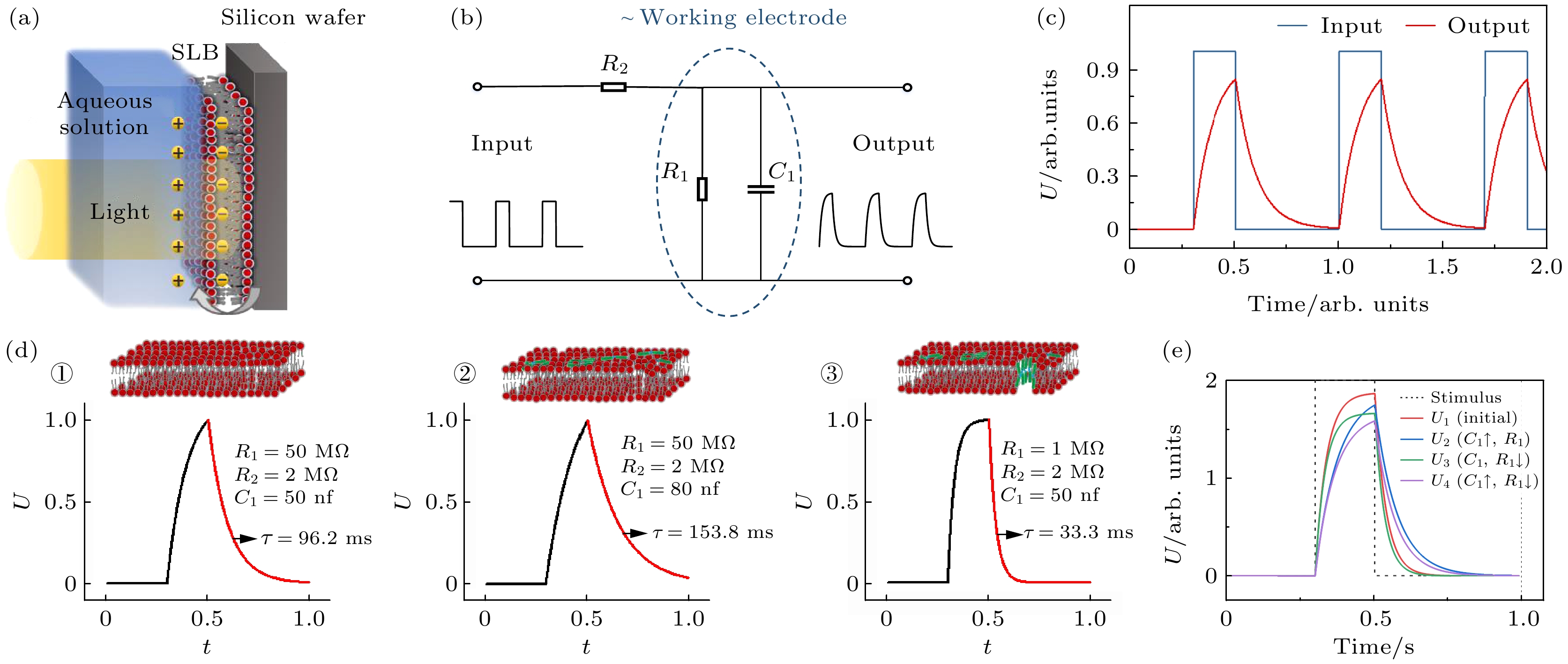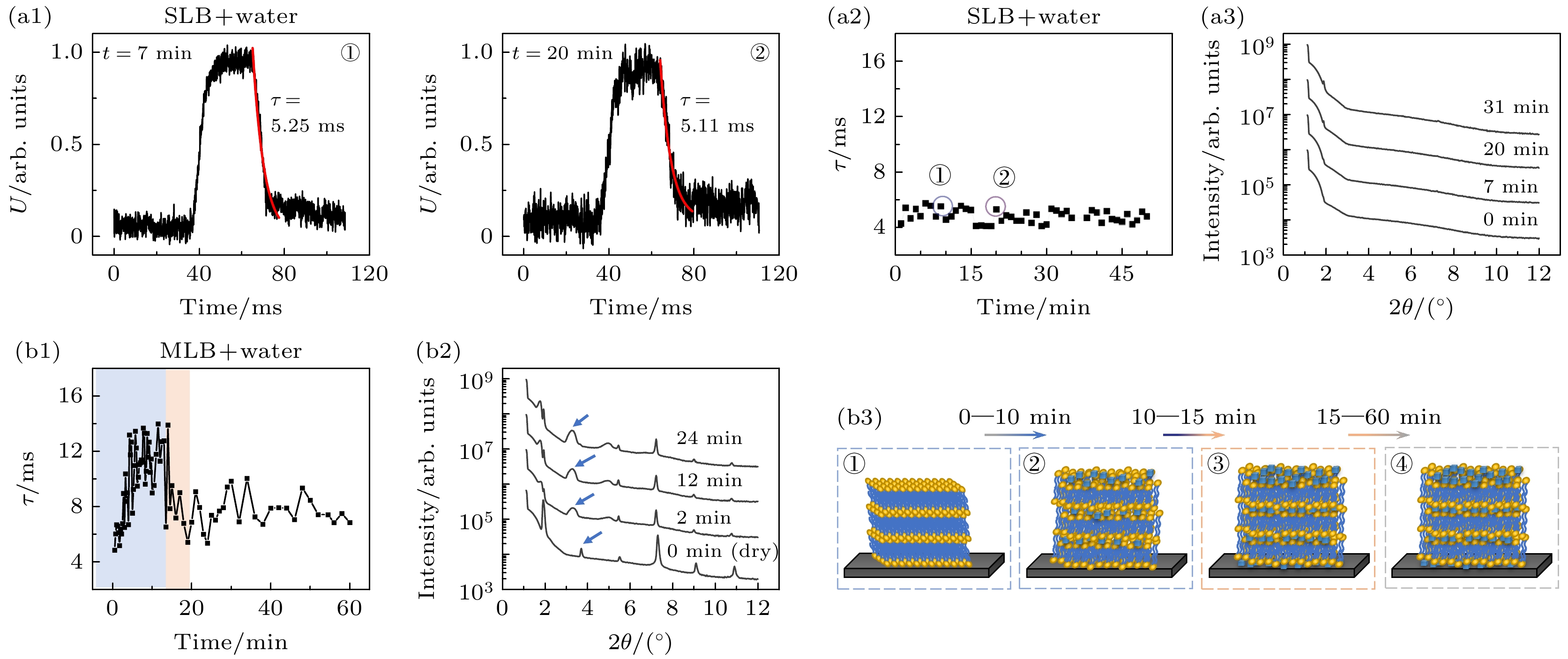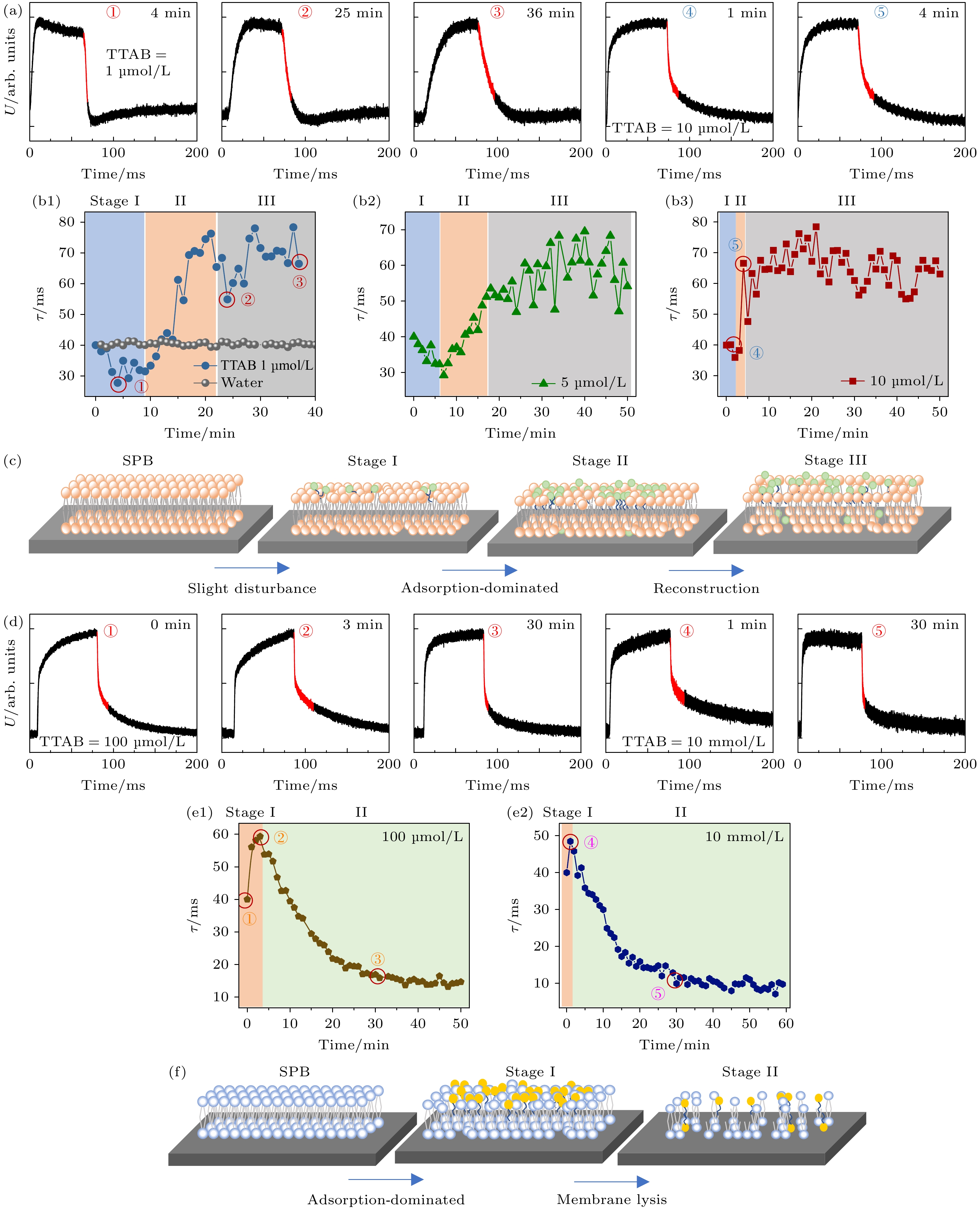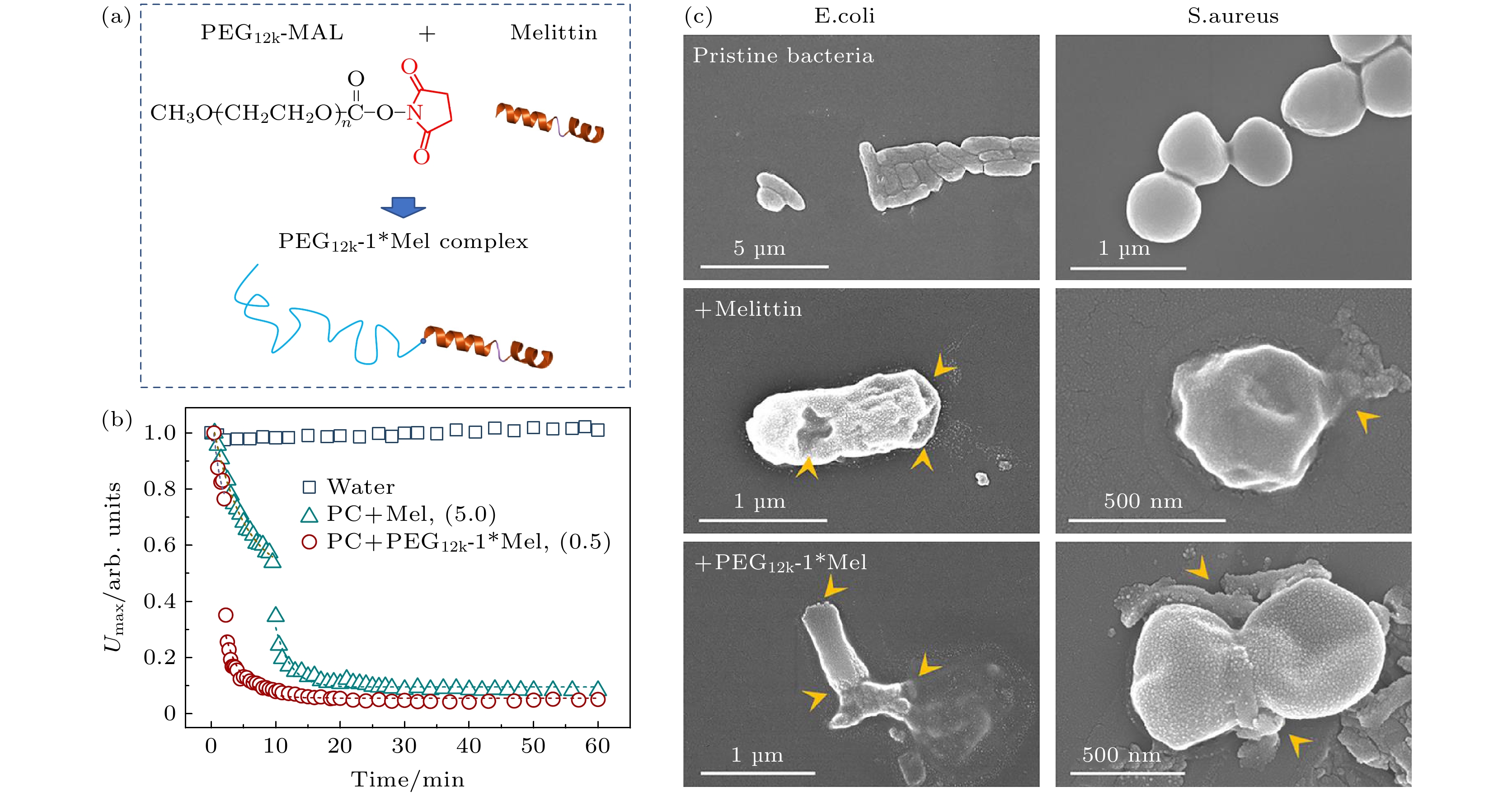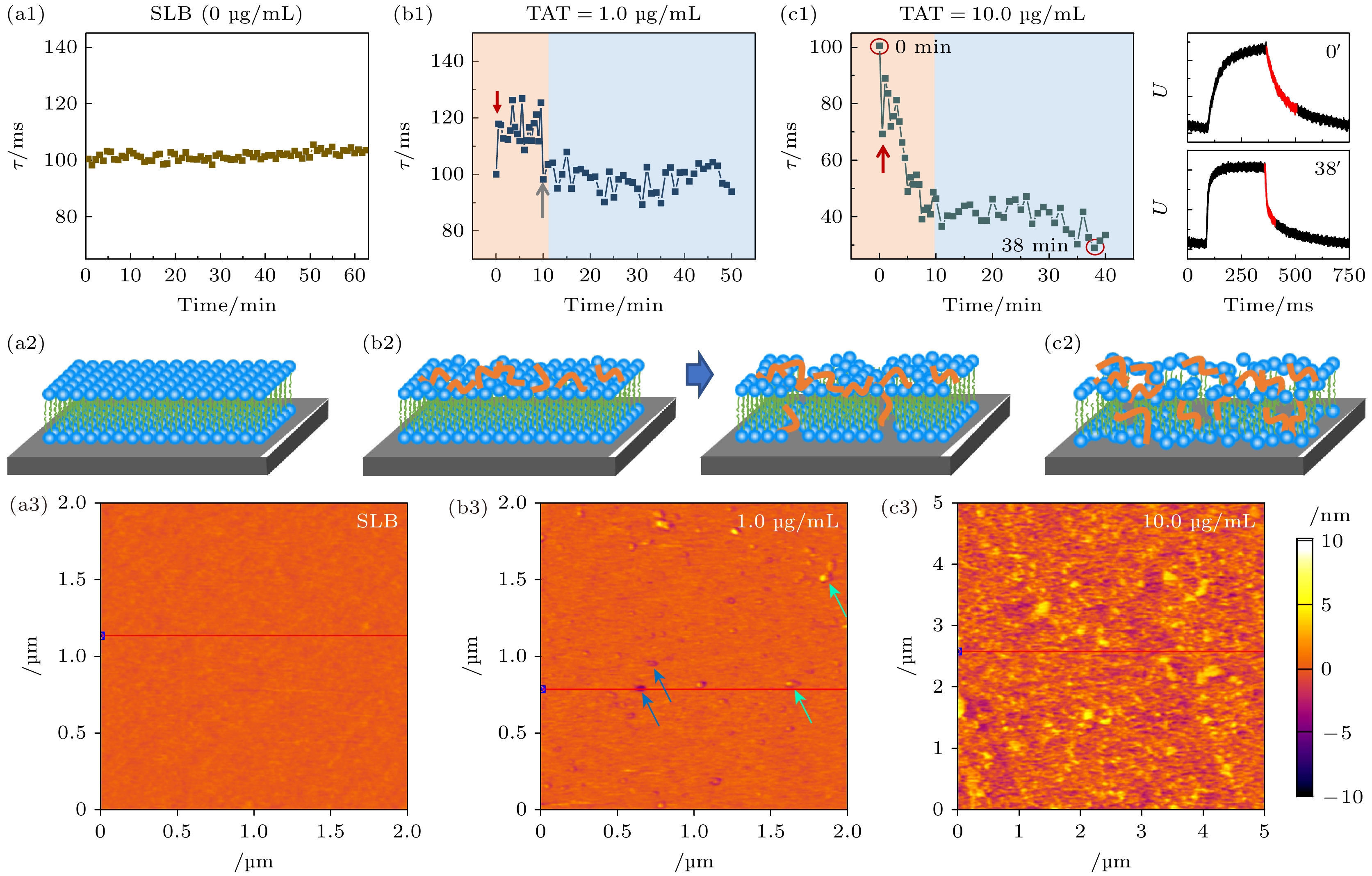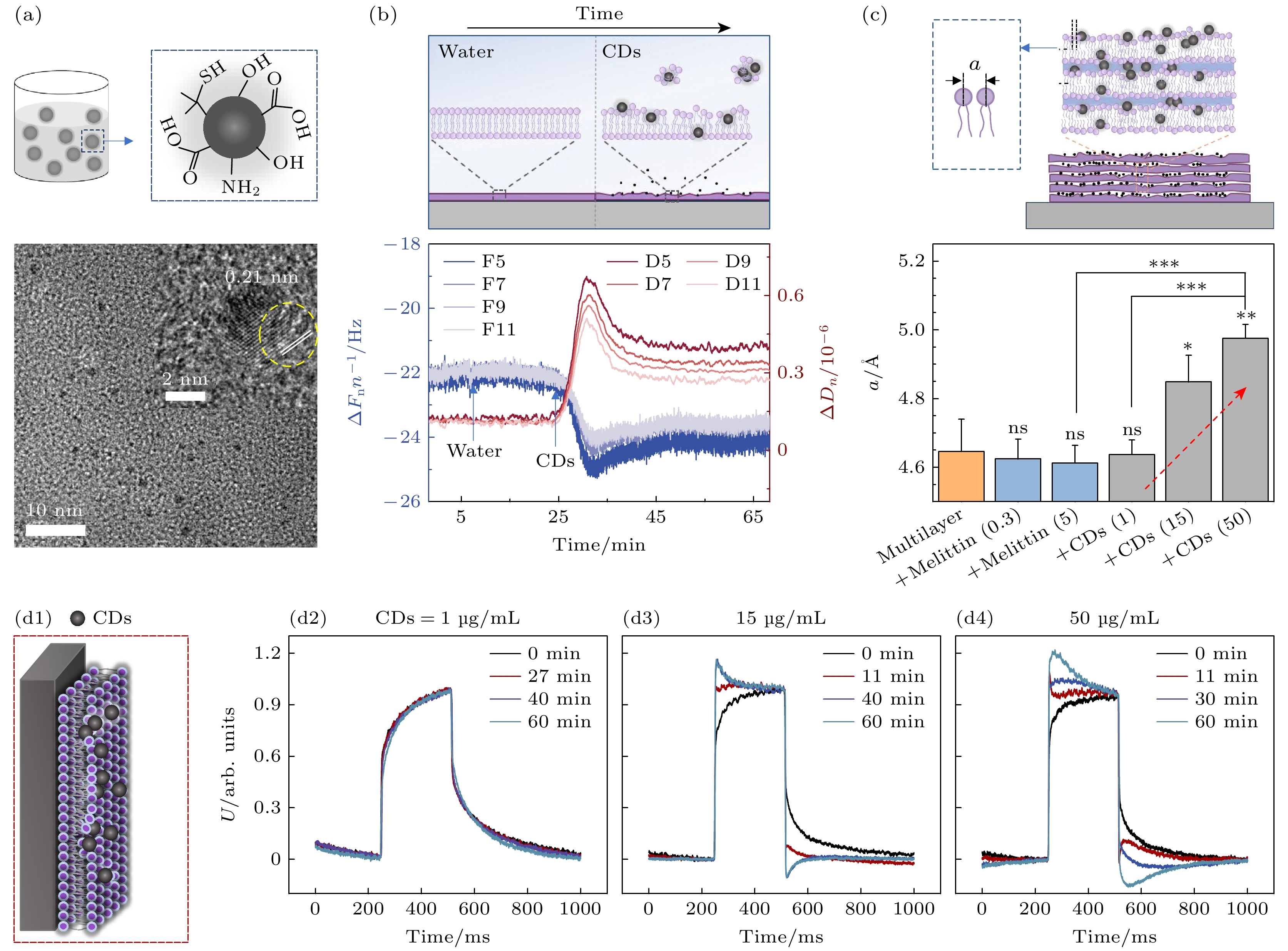-
活性分子与细胞膜之间的相互作用在许多基本的生物过程中扮演着至关重要的角色, 然而如何实现对此界面动力学过程的原位、实时、无标记且无侵入监测仍是生物物理研究领域所面临的一大挑战. 我们与合作者开发的光电压瞬态技术, 为解决这一问题提供了一种新途径. 该技术利用硅片光电响应生成电荷, 并将磷脂膜的充放电过程记录为电压瞬态脉冲、建立了该充放电过程与界面瞬时结构和性质之间的关联性. 因此, 通过对随时间演化的电压脉冲进行分析, 可以揭示活性分子作用下膜结构实时动态变化情况, 尤其是不同作用状态之间转换的时间信息, 可作为传统技术的有益补充. 同时, 该技术设备搭建成本低廉, 操作方便, 无需复杂的数据处理过程. 本综述概述了光电压瞬态技术的工作原理、设备搭建以及数据处理方法, 并以经典细胞膜模型——磷脂双层膜为例, 总结了该技术在探索磷脂膜水合特性及其与活性分子(如表面活性剂、聚合物、多肽和纳米颗粒)相互作用机制方面取得的最新进展. 最后就该技术优缺点进行讨论并展望未来发展前景.
The dynamic interactions between active molecules and the cell membrane play a crucial role in various fundamental biological processes. The photovoltage transient technique developed in recent years has provided an in situ, real-time, and non-invasive approach to studying dynamic processes at the membrane interface. In this technique, the photoelectric response of silicon wafers is used to generate charges and record voltage transient pulses in the charging and discharging process of phospholipid membranes. These pulses directly reflect the instantaneous structure and properties of the membrane. By analyzing the temporal evolution of voltage pulses, the dynamic changes in membrane structure induced by molecular actions can be elucidated. In particular, this technique provides valuable insights into the timing of transitions between different functional states. In this paper, the working principle, equipment setup, and data processing methods used in photovoltage transient analysis are comprehensively reviewed. Furthermore, the use of supported phospholipid bilayers as model cell membranes highlights recent progress of this technique in investigating the mechanisms underlying membrane interactions of active molecules such as surfactants, polymers, peptides, and nanoparticles. Finally, its advantages and limitations are evaluated, and its development prospects are discussed. The photovoltage transient technique is initially used to analyze the charging and discharging curves, as well as the hydration process, of single- and multi-layered membranes composed of 1,2-dioleoyl-sn-glycero-3-phosphocholine (DOPC) phospholipids. Previously, X-ray diffraction (XRD) and quartz crystal microbalance with dissipation (QCM-D) technology were commonly utilized for the real-time monitoring of the swelling process in phospholipid membranes, providing the information about changes in mass and thickness of Z-direction layers. In contrast, the photovoltage transient technique presents additional insights into the kinetics of the swelling process and timing of transitions between different stages. The present study demonstrates the effectiveness of photovoltage transient technique in real-time monitoring of membrane interface processes, specifically, it quantitatively measures the characteristic τ value of DOPC phospholipid membrane, thereby enabling further development of quantitative analysis method for this technique. Then, the photovoltage transient technique, in conjunction with giant unilamellar vesicle (GUV) leakage assays, atomic force microscopy (AFM) and QCM-D, is employed to monitor the structural perturbation of surfactants (TTAB) and polymers (Brij35 and PVPk30) on the membranes. Specifically, Brij35 primarily undergoes an adsorption-accumulation-penetration process; whereas PVPk30 exhibits a dynamic equilibrium between molecular adsorption-desorption and/or membrane permeation-healing competing mechanisms. This disparity in membrane action processes elucidates the discrepancy observed in their cytotoxicity during live cell experiments. The ability of photovoltage transient technology to investigate the entire membrane as a research subject along with its high sensitivity enables it to capture fluctuations in data points that reflect the coexistence of competitive mechanisms. Furthermore, photovoltage monitoring reveals the occurrence of peptide-induced membrane permeabilization. The distinct mechanism of action on the membrane between melittin (as a representative antimicrobial peptide) and TAT (a typical cell penetrating peptide) is elucidated. Finally, the conductive carbon dots (CDs) induced phenomena of membrane overcharging and overdischarging, are likely to be attributed to charge transfer between the silicon substrate and the embedded conductive CDs. -
Keywords:
- photo-voltage transient technique /
- cell membrane /
- interfacial dynamics /
- peptide-lipid interaction /
- supported lipid bilayer
[1] Garcia-Lopez V, Chen F, Nilewski L G, Duret G, Aliyan A, Kolomeisky A B, Robinson J T, Wang G, Pal R, Tour J M 2017 Nature 548 567
 Google Scholar
Google Scholar
[2] Dou Y J, Li J, Yuan B, Yang K 2014 Appl. Surf. Sci. 296 95
 Google Scholar
Google Scholar
[3] De Poli M, Zawodny W, Quinonero O, Lorch M, Webb S J, Clayden J 2016 Science 352 575
 Google Scholar
Google Scholar
[4] Dawson K A, Salvati A, Lynch I 2009 Nat. Nanotechn. 4 84
 Google Scholar
Google Scholar
[5] Roiter Y, Ornatska M, Rammohan A R, Balakrishnan J, Heine D R, Minko S 2008 Nano Lett. 8 941
 Google Scholar
Google Scholar
[6] Alexeev A, Uspal W E, Balazs A C 2008 ACS Nano 2 1117
 Google Scholar
Google Scholar
[7] Michel J P, Wang Y X, Kiesel I, Gerelli Y, Rosilio V 2017 Langmuir 33 11028
 Google Scholar
Google Scholar
[8] Xia H, Zhao Y 2020 Artif Cells Nanomed. Biotechnol. 48 197
 Google Scholar
Google Scholar
[9] Shadmani P, Mehrafrooz B, Montazeri A, Naghdabadi R 2020 J. Phys. Condens. Matter 32 115101
 Google Scholar
Google Scholar
[10] Last N B, Miranker A D 2013 Proc. Natl. Acad. Sci. U S A 110 6382
 Google Scholar
Google Scholar
[11] Weissmann G, Hirschhorn R, Krakauer K 1969 Biochem. Pharmacol. 18 1771
 Google Scholar
Google Scholar
[12] Barbasz A, Ocwieja M, Roman M 2017 Colloid. Surf. B 156 397
 Google Scholar
Google Scholar
[13] Vijayan V, Uthaman S, Park I K 2018 Polymers (Basel) 10 983
 Google Scholar
Google Scholar
[14] Han M L, Velkov T, Zhu Y, Roberts K D, Le Brun A P, Chow S H, Gutu A D, Moskowitz S M, Shen H H, Li J 2018 ACS Chem. Biol. 13 121
 Google Scholar
Google Scholar
[15] Khondker A, Dhaliwal A K, Saem S, Mahmood A, Fradin C, Moran-Mirabal J, Rheinstadter M C 2019 Commun. Biol. 2 67
 Google Scholar
Google Scholar
[16] Ista L K, Yu Q, Parthasarathy A, Schanze K S, Lopez G P 2016 Biointerphases 11 019003
 Google Scholar
Google Scholar
[17] Xu Y C, Lin J X, Cui T, Srinivas S, Feng Y J 2018 J. Biol. Chem. 293 4350
 Google Scholar
Google Scholar
[18] Keiderling T A, Lakhani A 2018 Chirality 30 238
 Google Scholar
Google Scholar
[19] Eun H J, Min A, Jeon C W, Yoo I, Heo J, Kim N J 2020 J. Phys. Chem. Lett. 11 4367
 Google Scholar
Google Scholar
[20] Schwaighofer A, Alcaraz M R, Araman C, Goicoechea H, Lendl B 2016 Sci. Rep. 6 33556
 Google Scholar
Google Scholar
[21] Hou S G, Liang L, Deng S H, Chen J F, Huang Q, Cheng Y, Fan C H 2014 Sci. China-Chem. 57 100
 Google Scholar
Google Scholar
[22] Li Y, Qian Z Y, Ma L, Hu S X, Nong D G, Xu C H, Ye F F, Lu Y, Wei G H, Li M 2016 Nat. Commun. 7 12906
 Google Scholar
Google Scholar
[23] Ma D, Hou W, Yang C, Hu S, Han W, Lu Y 2021 Biophys. Rep. 7 490
 Google Scholar
Google Scholar
[24] Xu C, Ma W D, Wang K, He K J, Chen Z L, Liu J J, Yang K, Yuan B 2020 J. Phys. Chem. Lett. 11 4834
 Google Scholar
Google Scholar
[25] Wu J F, Xu C, Ye Z F, Chen H B, Wang Y P, Yang K, Yuan B 2023 Small 19 2301713
 Google Scholar
Google Scholar
[26] Inoue O, Hasumi K 2019 J. Micro/Nanolith. MEM. 18 021206
 Google Scholar
Google Scholar
[27] Zhang B, Ma X L 2019 J. Mater. Sci. Technol. 35 1455
 Google Scholar
Google Scholar
[28] Eswara S, Pshenova A, Yedra L, Hoang Q H, Lovric J, Philipp P, Wirtz T 2019 Appl. Phys. Rev. 6 021312
 Google Scholar
Google Scholar
[29] Kosari A, Zandbergen H, Tichelaar F, Visser P, Terryn H, Mol A 2019 Corrosion 76 4
 Google Scholar
Google Scholar
[30] Li S Q, Chang Y J, Wang Y M, Xu Q, Ge B H 2020 Micron 130 102813
 Google Scholar
Google Scholar
[31] Chen P Y, Huang Y, Zhai X B, Huang Z H, Ma G H, Wei W, Yan L T 2019 Sci. Adv. 5 aaw3192
 Google Scholar
Google Scholar
[32] Xiao S F, Lu X M, Gou L, Li J L, Ma Y Q, Liu J J, Yang K, Yuan B 2019 Carbon 149 248
 Google Scholar
Google Scholar
[33] Suk H J, Boyden E S, van Welie I 2019 J. Neurosci. Methods 326 108357
 Google Scholar
Google Scholar
[34] de Pauli M, Gomes A M C, Cavalcante R L, Serpa R B, Reis C P S, Reis F T, Sartorelli M L 2019 Electrochim. Acta 320 134366
 Google Scholar
Google Scholar
[35] Marchioro A, Bischoff M, Lutgebaucks C, Biriukov D, Predota M, Roke S 2019 J. Phys. Chem. C 123 20393
 Google Scholar
Google Scholar
[36] Rao Y, Song D H, Turro N J, Eisenthal K B 2008 J. Phys. Chem. B 112 13572
 Google Scholar
Google Scholar
[37] Eisenthal K B 2006 Chem. Rev. 106 1462
 Google Scholar
Google Scholar
[38] Dou Y J, Li W W, Xia Y, Chen Z L, Wu Z L, Ge Y K, Lin Z, Zhang M L, Yang K, Yuan B, Kang Z H 2020 ACS Appl. Bio Mater. 4 620
 Google Scholar
Google Scholar
[39] Xia Y, Sun S Q, Zhang Z H, Ma W D, Dou Y J, Bao M M, Yang K, Yuan B, Kang Z H 2022 Phys. Chem. Chem. Phys. 24 5360
 Google Scholar
Google Scholar
[40] Ge Y K, Liu J J, Dou Y J, Chen Z L, Li Z H, Yang K, Yuan B, Kang Z H 2022 Colloid. Surf. B 209 112161
 Google Scholar
Google Scholar
[41] Yuan B, Liu J J, Deng Z X, Wei L, Li W W, Dou Y J, Chen Z L, Zhang C, Xia Y, Wang J, Zhang M L, Yang K, Ma Y Q, Kang Z H 2021 NPG Asia Mater. 13 18
 Google Scholar
Google Scholar
[42] Ma W, Sun S Q, Li W W, Zhang Z H, Lin Z, Xia Y, Yuan B, Yang K 2020 Langmuir 36 7190
 Google Scholar
Google Scholar
[43] Wei L, Tu W Q, Xu Y, Xu C, Dou Y J, Ge Y K, Sun S Q, Wei Y S, Yang K, Yuan B 2024 ACS Nano 18 18650
 Google Scholar
Google Scholar
[44] Sun S Q, Xia Y, Liu J, Dou Y J, Yang K, Yuan B, Kang Z 2022 J. Colloid Interface Sci. 609 707
 Google Scholar
Google Scholar
[45] Li W W, Ma Y, Ou L P, Xu C, Wei Y S, Yang K, Yuan B 2024 J. Hazard. Mater. 465 133382
 Google Scholar
Google Scholar
[46] Wei Y S, Chen H B, Li Y X, He K J, Yang K, Pang H B 2022 ACS Nano 16 5885
 Google Scholar
Google Scholar
[47] Ou L P, Chen H B, Yuan B, Yang K 2022 ACS Nano 16 18090
 Google Scholar
Google Scholar
-
图 1 光电压测试系统和反应仓的照片及示意图 (a) 设备照片, 该套系统包含置于电磁屏蔽箱内的反应仓(内含工作电极和 参比电极)、信号放大模块、信号采集模块、可控光源和计算机, 其中插图为对应的模块分布示意图; (b) 反应仓照片, 功能夹具 可实现方便和稳定的样品安装和实验测量; (c) 反应仓示意图, 反应仓由浸泡于活性分子溶液中的硅片及其表面覆盖的磷脂膜(无膜部分以绝缘胶覆盖)、参比电极、方波调制的光照组成, 工作电极与参比电极之间的电压差被实时采集; 部分图片引用和 修改自文献[38]
Fig. 1. Photos and schematic diagrams of the photovoltaic testing system and reaction chamber. (a) Photo of the experimental setup. The system includes a reaction chamber (containing working electrodes and reference electrodes) placed inside an electromagnetic shielding box, a signal amplification module, a signal acquisition module, a controllable light source, and a computer. Inset shows simplified settlement of the system. (b) Photo of the reaction chamber. The functional fixture can achieve convenient and stable sample installation and experimental measurement. (c) Schematic diagram of the reaction chamber, which consists of a silicon wafer immersed in an active molecule solution and its surface covered with a phospholipid membrane (the non membrane part is covered with insulating glue), a reference electrode, and square wave modulated light. The voltage difference between the working electrode and the reference electrode is collected in real time. Images are cited and modified from Ref. [38].
图 2 光电压测试系统的简化等效电路及数值仿真 (a) 工作电极示意图, 硅片基底在方波调制光照下发生光电响应和生成电荷, 导致膜液界面双电层发生充放电; (b) 简化等效电路, 其中, 可变电阻$ {R}_{1} $与可变电容$ {C}_{1} $的并联等效于工作电极的贡献; (c) 输入信号与输出信号的典型仿真曲线, 分别为方波信号和变形方波信号; (d) 膜结构改变与输出电压曲线之间的关联, $ {R}_{1} $, $ {R}_{2} $, $ {C}_{1} $取假设数值、对应于不同膜结构, 曲线为基于等效电路的仿真结果, τ为基于曲线计算出的弛豫时间常数; (e) 膜结构变化(即$ {R}_{1} $, $ {C}_{1} $数值改变)导致的充放电曲线对比. 部分图片引用和修改自文献[38]
Fig. 2. Simplified equivalent circuit and numerical simulation of photovoltage testing system. (a) Schematic diagram of the working electrode. The silicon wafer substrate undergoes photoelectric response and generates charges under square wave modulation light, resulting in charging and discharging of the double layer at the film liquid interface. (b) Equivalent circuit of the test system, where the parallel connection of variable resistor R1 and variable capacitor C1 is equivalent to the contribution of the working electrode. (c) Representative simulation profiles of the input (in blue) and output (red) signals, they are square wave signal and deformed square wave signal, respectively. (d) Relationship between changes in membrane structure and changes in the output profile. The input postulated values of $ {R}_{2} $, $ {R}_{1} $ and $ {C}_{1} $, as well as the as-calculated τ value based on the circuit in (b) are shown in each condition. (e) Comparison between photo-voltage pulses due to changes in $ {R}_{1} $ and $ {C}_{1} $values. Images are cited and modified from Ref. [38].
图 3 光电压瞬态技术中的数据采集与分析方法举例 (a) 纯DOPC单层磷脂膜的典型充放电曲线; (b) 加入TAT多肽38 min后, 体系的充放电曲线; (c) 纯DOPC多层膜(MLB)与蜂毒肽相互作用不同时刻的体系充放电曲线; (d) 纯DOPC单层膜与碳点(carbon dots, CDs)相互作用不同时刻的体系充放电曲线. (a)—(d)皆显示了一个脉冲的典型曲线. 脉冲的时间长度取决于实验设定的光脉冲ON、OFF时长, 不影响对τ值的计算. (a), (b), (d)中展示了电压经归一化处理之后的结果; (c)显示了未经归一化处理的原始曲线. 图片引用和修改自文献[44,45]
Fig. 3. Examples of data acquisition and analysis methods in photovoltage transient technology: (a) The charge and discharge curve of a pure DOPC SLB, voltage is normalized; (b) the charge and discharge curve of the system after adding TAT peptide for 38 minutes, voltage is normalized; (c) the charge and discharge curves of pure DOPC MLB with melittin at different time points of interaction, voltage is not normalized; (d) the charge and discharge curves of pure DOPC SLB interacting with carbon dots (CDs) at different time intervals, voltage is normalized. Panels (a)–(d) all exhibit typical curves of pulses, and the duration of the pulses depends on the experimentally set ON and OFF duration of the light pulses, which does not affect the calculation of the value of τ images are cited and modified from Ref. [44,45].
图 4 纯DOPC单层膜(a1)—(a3)和多层膜(b1)—(b3)在光电压瞬态分析中的典型充放电曲线及其水合过程 (a)单层膜在不同时刻的充放电曲线、水合过程中τ值随时间的演变、及不同时刻的室内XRD曲线(典型测量结果); (b)多层膜在水合过程中τ值随时间的演变、不同时刻的室内XRD曲线、及对应的水合过程示意图, 蓝色珠子代表水分子, 其中(b1), (b2)为典型测量结果. 图片引用和修改自文献[38]
Fig. 4. Typical charge-discharge curves and hydration processes of pure DOPC SLB (a1)–(a3) and MLB (b1)–(b3) membranes in photovoltage transient analysis. (a) The charge and discharge curves of a SLB at different time points, along with the evolution of τ value during hydration and XRD curve at various time intervals (typical measurement results). (b) The evolution of τ value over time, indoor XRD curves at different time points, and corresponding hydration process diagram for the MLB. The blue beads represent water molecules. (b1), (b2) are typical measurement results. Images are cited and modified from Ref. [38].
图 5 光电压瞬态技术分析不同浓度TTAB与DOPC磷脂单层膜相互作用的动态过程 (a), (d)典型的光电压脉冲曲线, 其对应的采集时刻以圆圈标于(b), (e)中; (b), (e) TTAB与磷脂膜相互作用过程中τ随时间演化的典型曲线, 体系初始τ值被归一化至40 ms, TTAB浓度分别为1, 5, 10, 100 μmol/L和10 mmol/L, 不同的作用阶段以不同背景色标出; (c), (f) 不同阶段中TTAB与脂质相互作用机制示意图. 图片引用和修改自文献[39]
Fig. 5. Dynamic interaction between TTAB and a DOPC SLB with varying concentrations under the photovoltage transient analysis. (a), (d) Typical photovoltage pulse curves, with the corresponding acquisition time circled in (b), (e). (b), (e) Typical time evolution of τ during the interaction between TTAB and a DOPC membrane. The initial value in each test was normalized to 40 ms. The concentrations of TTAB used were 1, 5, 10, 100 μmol/L and 10 mmol/L respectively. Different stages of action are indicated by different background colors. (c), (f) Schematic diagrams illustrating the interaction process between TTAB and lipids. Images are cited and modified from Ref. [39].
图 6 蜂毒肽(melittin)及其复合物(PEG12k-1*Mel)的膜作用活性分析 (a) PEG12k-1*Mel的制备及分子构象示意图; (b)光电压瞬态技术检测两种分子与SLB (成分为纯DOPC)的相互作用过程中Umax随时间的演变, 在0时刻加入药物分子, 浓度分别为5.0和0.5 μg/mL (以分子内多肽质量为标准来标定复合物浓度); (c)两种分子杀菌效果的SEM照片(药物浓度皆为64 μg/mL, 孵育时间16 h). 箭头标出了细菌膜破裂的位置. 图片引用和修改自文献[41]
Fig. 6. Membrane activity of melittin and PEG12k-1*Mel: (a) Conjugation route of the PEG12k-1*Mel complex; (b) typical Umax-t profiles of DOPC membranes exposed to DI water, pure melittin (5.0 µg/mL) or PEG12k-1*Mel (0.5 µg/mL); (c) representative SEM images of E. coli and S. aureus bacteria after 16 h exposure to native melittin, PEG12k-1*Mel (peptide concentration of 64 µg/mL (in respect to peptide)), or no agent, where arrowheads indicate collapses of bacterial membrane. Images are cited and modified from Ref. [41].
图 7 TAT多肽与磷脂膜相互作用过程的实时分析 (a1), (b1), (c1)不同浓度TAT (0, 1.0, 10.0 μg/mL)与DOPC膜相互作用过程的代表性τ-t曲线, 多肽-膜重构阶段以浅蓝色背景标记; (c1)右图为两个代表时刻(以红色圈标出)对应的电压脉冲; (a2), (b2), (c2) 对应的膜结构示意图, (b2)中蓝色和绿色箭头分别标出膜上的孔洞和吸附的颗粒; (a3), (b3), (c3) TAT孵育后DOPC 平板膜的AFM形貌图. 图片引用和修改自文献[44]
Fig. 7. Real-time monitoring the interactions between TAT and a supported DOPC bilayer membrane using photo-voltage transient test. (a1), (b1), (c1) Representative τ-t profiles upon TAT exposure at 0, 1.0 and 10.0 μg/mL, respectively. The membrane reconstruction process is marked with a light blue background. The voltage pulses corresponding to the two circled points are representatively shown. The right figure shows the voltage pulses corresponding to two representative moments (marked in red circles). (a2), (b2), (c2) Corresponding membrane structures, blue and green arrows respectively mark the pores and adsorbed particles on the membrane in (b2). (a3), (b3), (c3) AFM topographies of DOPC SLBs after TAT incubation. Images are cited and modified from Ref. [44].
图 8 弱负电CDs对磷脂膜结构和电性质的扰动情况分析 (a)碳点的表面基团示意图及透射电子显微镜表征; (b)利用QCM-D实时记录CDs (浓度为50 μg/mL)与SLB的相互作用过程及CDs导致的脂膜双层结构不对称破坏, 箭头表示使用蠕动泵在10 mL/min的流速和25 ℃下向SLB中添加超纯水或CD的时间; (c)同步辐射XRD分析CDs对磷脂多层膜的层内磷脂间距(a)的影响, 原始溶液含有脂质(浓度为200 μg/mL), CDs浓度分别为1, 15, 50 μg/mL; (d)光电压瞬态实验分析CDs对SLB电性质的影响, 显示了典型的输出电压分布, 描绘了引入不同浓度CD后SLB的时间演变; (b)—(d)对应显示了可能的CDs导致膜结构扰动情况. 图片引用和修改自文献[45]
Fig. 8. Impact of CDs on the structure and electrical properties of phospholipid membranes. (a) Schematic diagram, transmission electron microscopy (TEM) and high-resolution TEM images illustrating the morphology of CDs. (b) Asymmetric disruption of the two leaflets of bilayer membrane due to CD adsorption and perturbation under real-time QCM-D analysis, where arrows indicate the addition time of ultrapure water or CDs (at 50 μg/mL) to a SLB using a peristaltic pump at a flow rate of 10 mL/min and 25 ℃. (c) Synchrotron radiation XRD analysis of the CD-lipid composite structure. XRD analysis was performed on films composed of mixtures of DOPC lipids and varying concentrations of CDs or melittin, and the in-plane inter-lipid spacing, a, was demonstrated. The pristine solution contained lipids (at a concentration of 200 μg/mL), CDs ranging from 1 to 50 μg/mL. (d) The impact of CDs on the electrical properties of SLBs under photo-voltage analysis. Typical output voltage profiles were shown depicting the temporal evolution of the SLB subsequent to the introduction of CDs at different concentrations. (b)–(d) corresponding display of possible CDs causing membrane structure disturbance. Images are cited and modified from Ref. [45].
-
[1] Garcia-Lopez V, Chen F, Nilewski L G, Duret G, Aliyan A, Kolomeisky A B, Robinson J T, Wang G, Pal R, Tour J M 2017 Nature 548 567
 Google Scholar
Google Scholar
[2] Dou Y J, Li J, Yuan B, Yang K 2014 Appl. Surf. Sci. 296 95
 Google Scholar
Google Scholar
[3] De Poli M, Zawodny W, Quinonero O, Lorch M, Webb S J, Clayden J 2016 Science 352 575
 Google Scholar
Google Scholar
[4] Dawson K A, Salvati A, Lynch I 2009 Nat. Nanotechn. 4 84
 Google Scholar
Google Scholar
[5] Roiter Y, Ornatska M, Rammohan A R, Balakrishnan J, Heine D R, Minko S 2008 Nano Lett. 8 941
 Google Scholar
Google Scholar
[6] Alexeev A, Uspal W E, Balazs A C 2008 ACS Nano 2 1117
 Google Scholar
Google Scholar
[7] Michel J P, Wang Y X, Kiesel I, Gerelli Y, Rosilio V 2017 Langmuir 33 11028
 Google Scholar
Google Scholar
[8] Xia H, Zhao Y 2020 Artif Cells Nanomed. Biotechnol. 48 197
 Google Scholar
Google Scholar
[9] Shadmani P, Mehrafrooz B, Montazeri A, Naghdabadi R 2020 J. Phys. Condens. Matter 32 115101
 Google Scholar
Google Scholar
[10] Last N B, Miranker A D 2013 Proc. Natl. Acad. Sci. U S A 110 6382
 Google Scholar
Google Scholar
[11] Weissmann G, Hirschhorn R, Krakauer K 1969 Biochem. Pharmacol. 18 1771
 Google Scholar
Google Scholar
[12] Barbasz A, Ocwieja M, Roman M 2017 Colloid. Surf. B 156 397
 Google Scholar
Google Scholar
[13] Vijayan V, Uthaman S, Park I K 2018 Polymers (Basel) 10 983
 Google Scholar
Google Scholar
[14] Han M L, Velkov T, Zhu Y, Roberts K D, Le Brun A P, Chow S H, Gutu A D, Moskowitz S M, Shen H H, Li J 2018 ACS Chem. Biol. 13 121
 Google Scholar
Google Scholar
[15] Khondker A, Dhaliwal A K, Saem S, Mahmood A, Fradin C, Moran-Mirabal J, Rheinstadter M C 2019 Commun. Biol. 2 67
 Google Scholar
Google Scholar
[16] Ista L K, Yu Q, Parthasarathy A, Schanze K S, Lopez G P 2016 Biointerphases 11 019003
 Google Scholar
Google Scholar
[17] Xu Y C, Lin J X, Cui T, Srinivas S, Feng Y J 2018 J. Biol. Chem. 293 4350
 Google Scholar
Google Scholar
[18] Keiderling T A, Lakhani A 2018 Chirality 30 238
 Google Scholar
Google Scholar
[19] Eun H J, Min A, Jeon C W, Yoo I, Heo J, Kim N J 2020 J. Phys. Chem. Lett. 11 4367
 Google Scholar
Google Scholar
[20] Schwaighofer A, Alcaraz M R, Araman C, Goicoechea H, Lendl B 2016 Sci. Rep. 6 33556
 Google Scholar
Google Scholar
[21] Hou S G, Liang L, Deng S H, Chen J F, Huang Q, Cheng Y, Fan C H 2014 Sci. China-Chem. 57 100
 Google Scholar
Google Scholar
[22] Li Y, Qian Z Y, Ma L, Hu S X, Nong D G, Xu C H, Ye F F, Lu Y, Wei G H, Li M 2016 Nat. Commun. 7 12906
 Google Scholar
Google Scholar
[23] Ma D, Hou W, Yang C, Hu S, Han W, Lu Y 2021 Biophys. Rep. 7 490
 Google Scholar
Google Scholar
[24] Xu C, Ma W D, Wang K, He K J, Chen Z L, Liu J J, Yang K, Yuan B 2020 J. Phys. Chem. Lett. 11 4834
 Google Scholar
Google Scholar
[25] Wu J F, Xu C, Ye Z F, Chen H B, Wang Y P, Yang K, Yuan B 2023 Small 19 2301713
 Google Scholar
Google Scholar
[26] Inoue O, Hasumi K 2019 J. Micro/Nanolith. MEM. 18 021206
 Google Scholar
Google Scholar
[27] Zhang B, Ma X L 2019 J. Mater. Sci. Technol. 35 1455
 Google Scholar
Google Scholar
[28] Eswara S, Pshenova A, Yedra L, Hoang Q H, Lovric J, Philipp P, Wirtz T 2019 Appl. Phys. Rev. 6 021312
 Google Scholar
Google Scholar
[29] Kosari A, Zandbergen H, Tichelaar F, Visser P, Terryn H, Mol A 2019 Corrosion 76 4
 Google Scholar
Google Scholar
[30] Li S Q, Chang Y J, Wang Y M, Xu Q, Ge B H 2020 Micron 130 102813
 Google Scholar
Google Scholar
[31] Chen P Y, Huang Y, Zhai X B, Huang Z H, Ma G H, Wei W, Yan L T 2019 Sci. Adv. 5 aaw3192
 Google Scholar
Google Scholar
[32] Xiao S F, Lu X M, Gou L, Li J L, Ma Y Q, Liu J J, Yang K, Yuan B 2019 Carbon 149 248
 Google Scholar
Google Scholar
[33] Suk H J, Boyden E S, van Welie I 2019 J. Neurosci. Methods 326 108357
 Google Scholar
Google Scholar
[34] de Pauli M, Gomes A M C, Cavalcante R L, Serpa R B, Reis C P S, Reis F T, Sartorelli M L 2019 Electrochim. Acta 320 134366
 Google Scholar
Google Scholar
[35] Marchioro A, Bischoff M, Lutgebaucks C, Biriukov D, Predota M, Roke S 2019 J. Phys. Chem. C 123 20393
 Google Scholar
Google Scholar
[36] Rao Y, Song D H, Turro N J, Eisenthal K B 2008 J. Phys. Chem. B 112 13572
 Google Scholar
Google Scholar
[37] Eisenthal K B 2006 Chem. Rev. 106 1462
 Google Scholar
Google Scholar
[38] Dou Y J, Li W W, Xia Y, Chen Z L, Wu Z L, Ge Y K, Lin Z, Zhang M L, Yang K, Yuan B, Kang Z H 2020 ACS Appl. Bio Mater. 4 620
 Google Scholar
Google Scholar
[39] Xia Y, Sun S Q, Zhang Z H, Ma W D, Dou Y J, Bao M M, Yang K, Yuan B, Kang Z H 2022 Phys. Chem. Chem. Phys. 24 5360
 Google Scholar
Google Scholar
[40] Ge Y K, Liu J J, Dou Y J, Chen Z L, Li Z H, Yang K, Yuan B, Kang Z H 2022 Colloid. Surf. B 209 112161
 Google Scholar
Google Scholar
[41] Yuan B, Liu J J, Deng Z X, Wei L, Li W W, Dou Y J, Chen Z L, Zhang C, Xia Y, Wang J, Zhang M L, Yang K, Ma Y Q, Kang Z H 2021 NPG Asia Mater. 13 18
 Google Scholar
Google Scholar
[42] Ma W, Sun S Q, Li W W, Zhang Z H, Lin Z, Xia Y, Yuan B, Yang K 2020 Langmuir 36 7190
 Google Scholar
Google Scholar
[43] Wei L, Tu W Q, Xu Y, Xu C, Dou Y J, Ge Y K, Sun S Q, Wei Y S, Yang K, Yuan B 2024 ACS Nano 18 18650
 Google Scholar
Google Scholar
[44] Sun S Q, Xia Y, Liu J, Dou Y J, Yang K, Yuan B, Kang Z 2022 J. Colloid Interface Sci. 609 707
 Google Scholar
Google Scholar
[45] Li W W, Ma Y, Ou L P, Xu C, Wei Y S, Yang K, Yuan B 2024 J. Hazard. Mater. 465 133382
 Google Scholar
Google Scholar
[46] Wei Y S, Chen H B, Li Y X, He K J, Yang K, Pang H B 2022 ACS Nano 16 5885
 Google Scholar
Google Scholar
[47] Ou L P, Chen H B, Yuan B, Yang K 2022 ACS Nano 16 18090
 Google Scholar
Google Scholar
计量
- 文章访问数: 2390
- PDF下载量: 76
- 被引次数: 0













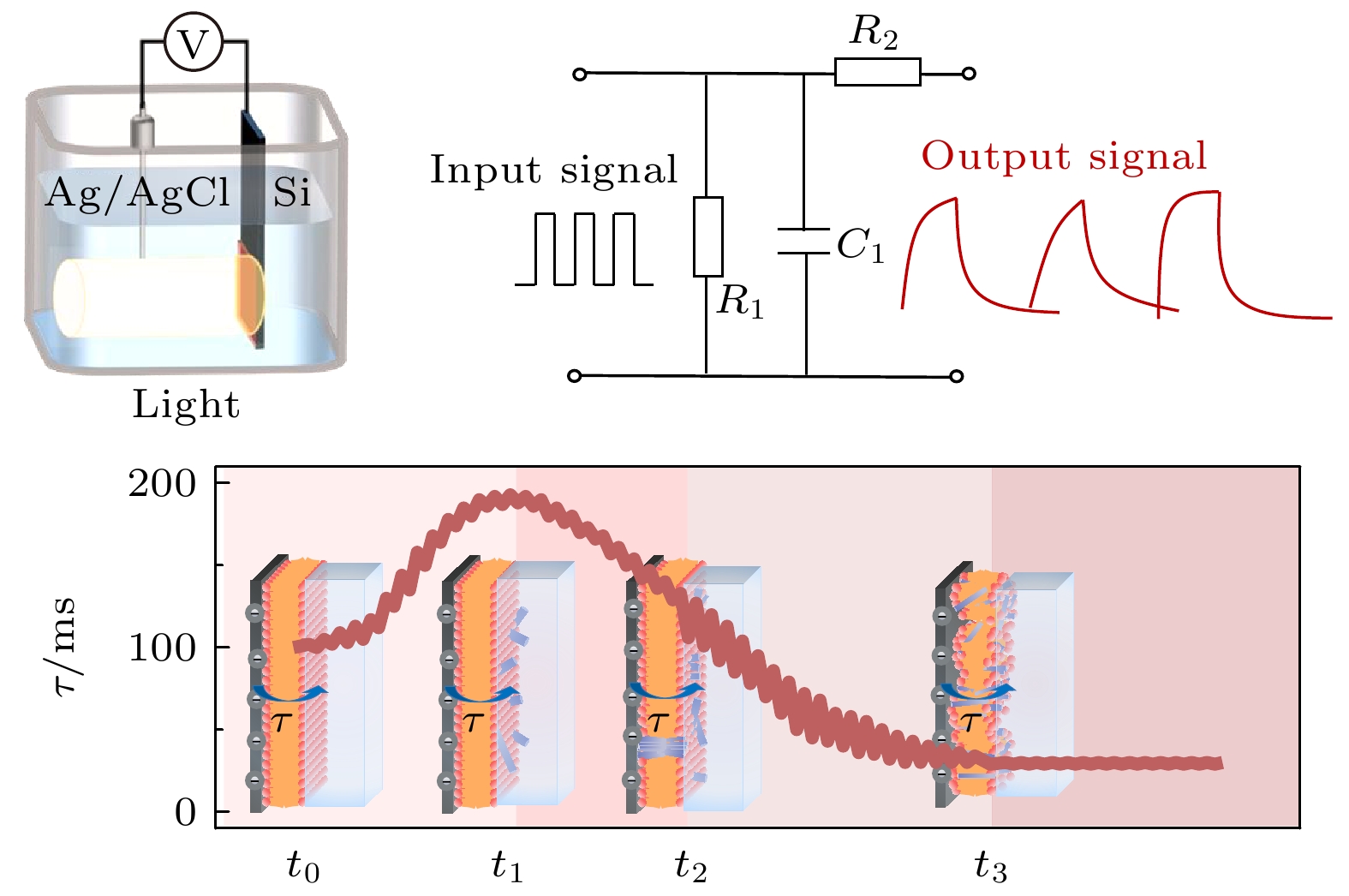
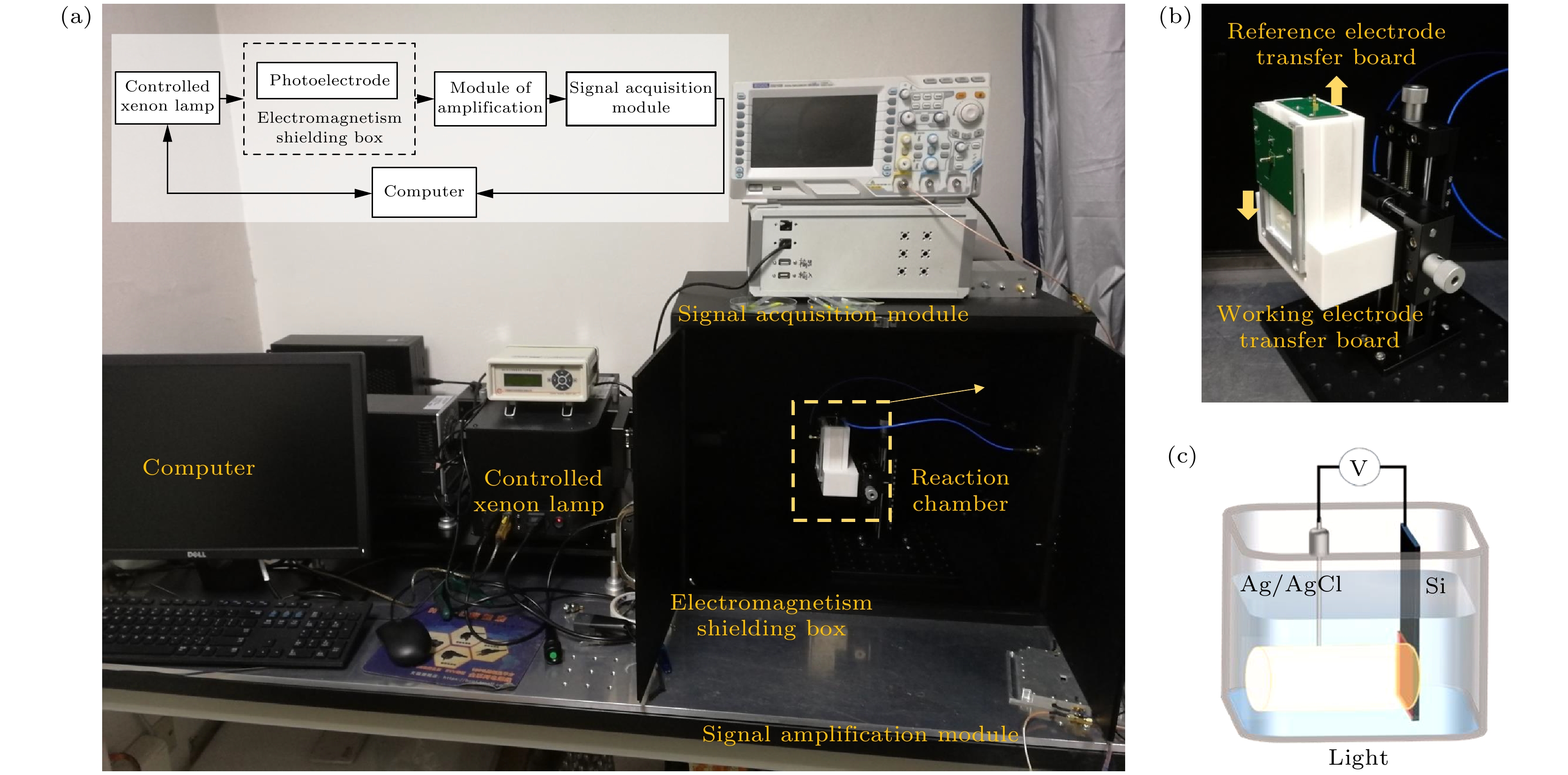
 下载:
下载:
